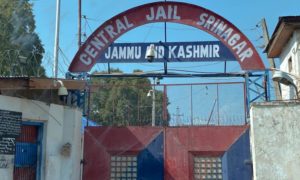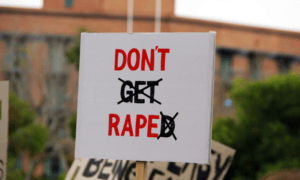From the browbeaten lanes of Old City to the battered countryside vicinity of Kunan Poshpora, the women of Kashmir have picked up an unusual routine over the years to cope with the traumatic memories. This, many say, is their way of resisting the enforced forgetfulness and treacherous state of affairs in their homeland.
It was a typical day of devotion inside the revered Dastgeer Sahib Shrine at Khanyar in Old City. The faithful were busy feeding mendicants, sitting near the shrine entrance. Others being swarmed by devotees to get a sanctified piece of meat being distributed inside the shrine yard.
From the inside, the pleading voices, imploring for everything under the sky could be heard. In this characteristic shrine ambiance a woman walked in with a steel jug in her hand.
As if weighed down by some unspoken grief, she staggered in a hunched, lazy manner. Wearing somewhat lost eyes on her parched face, she sat in front of the shrine door. Even as a chain of devotees created commotion around, she sat silent, fixing her absorbed gaze at the spot where women were either crying their hearts out or seeking the saint’s intervention in their mundane matters.
Some half an hour passed in this fix and yet, the old mother stood unruffled, still gazing at the saint’s supposed abode. Shortly, she was mumbling something, as if talking to the saint. Then, apparently flashing one last complaining look towards the shrine, she rose up and began walking away. Soon she was lost on the bustling street crowd outside.
“Her name is Aisha Bobe,” says a shrine custodian, offering handful of Shirin, a traditional Kashmiri sweetmeat ball, to arriving devotees inside. “Ever since the day her youngest son’s dead body was delivered to her home, she regularly shows up here.”
That happened in the mid-90s, he continued voicing anguish amid the submissive shrine ambiance. “One of her relatives told me once that she had pleaded for her slain son’s birth at this shrine during the seventies and had even tied a votive rag as a wish for him here,” he says. “Once she was blessed with the baby boy, she would regularly visit the shrine, praying for his well-being.”
When Kashmir was still in the thick of the war during the nineties, Aisha’s son—then a 20-year-old bright student—was dragged out of his friend’s place and killed, on a rainy night, hardly 3km from his home in Nowhatta.
ALSO READ: The dead silence that prevails over Batkoot’s bloody Sunday
“And since then,” the shrine custodian says, “the mother silently walks in, sits at the shrine doorsteps and fixes her gaze at the saint—as if complaining to him: ‘Weren’t you supposed to take care of him?’ ”
It’s this silent conversation which is now engaging this mother with the memories of her lost son, killed some 23 years back.
Much of this might sound a melodramatic presentation of one’s loss, but for somebody like Kashmir’s prominent psychiatrist Dr. Arshad Hussain, the mother Aisha’s case makes routine, as for years now, he has been treating such mothers.
“Aisha’s case reminds me of a mother from south Kashmir who used to visit the Aishmuqam shrine in a similar state to cope with her trauma and stress,” Dr Arshad says. That’s how the mothers would visit these religious places as per their belief system to put their trauma in perspective, he continued.
“They believe that the physical distance created by death can be transcended between them and their slain sons,” the mental health specialist says. “That’s why by talking or musing at the shrine, they believe as if they’re talking with their own sons whose physical absence is void in the heart which can only be plugged by God and the promised reunion is distant but not impossible, they firmly believe that distance is of body and not soul. This is how most of these mothers show resilience and are coping in face of tremendous suffering and longing.”
Unlike mother Aisha’s way of coping with the memories of her slain son, the doctor says, many conflict-ridden Kashmiri women have developed their own defense mechanisms to live with their memories. While the pre-dawn shrine forays of such mothers are quite known in Old City and elsewhere, others have picked up different routines.
In the defiant Maisuma area, the case of distraught mother Shahzada Rafiq is quite familiar. At the peak of the 2010 summer uprising, her 28-year-old son, Yasir Rafiq, was shot dead while playing carom with his friends in the calm street outside. Since then, she either rises up from her bed in the middle of the night or early dawn to write elegies in his remembrance. “She forgot cooking all these years,” said her relative, “but she never skipped weaving a verse in his remembrance.”
ALSO READ: How Kashmir’s mentally unstable have been used as cannon fodder
But the sad reality of Kashmir doesn’t make Aisha, or Shahzada, the only instances of their kind.
When Tral’s 30-year-old poet-mystic Nazir Shah was killed by the Indian armed forces in 1995, his mother Taja stepped into his shoes by writing poetry, mostly elegies, in longing for her son.
And given the teething tragedies which Kashmir have suffered in an unequal war—turning 30-year-old next year, many women have picked up their own routines to preserve the memories. One mother in Haarwan has kept her slain son’s school uniform and satchels intact. Many have turned their slain—or disappeared—son’s rooms into shut spaces.
Amid this state of affairs, the personal abuse inflicted on Kashmiri women has long redefined their routines.
ALSO READ: Not submissive, but combative: Kashmir’s superwomen
When on June 22, 2013, the Kunan Poshpora mass-rape victims made their first public appearance in a Srinagar seminar, they spoke, sobbingly, how tough it was for them to commit the nightmarish episode to their memories all these years — ‘when our children keep asking us, were you subjected to rape?’
Some 40 women were gang-raped by 4 Rajputana Rifles of the Indian Army in the intervening night of February 22-23, 1991 at Kunan Poshpora village of north Kashmir’s Kupwara district. By the time, they came to Srinagar on the invitation of a local rights body, some half a dozen of them had already died and some 22 years and 4 months had already passed in between.
For the survivors of that ‘darkest night’, the memories had tested their daily routine. Recalling how the army men had cordoned off their village to conduct a search operation at around 11:00pm and raped them overnight till the next morning, would make them relive that night all over again.
“It seems as if that night hasn’t ended yet,” one of the masked victims told me in sidelines of the seminar that day. “Somehow we managed to remind ourselves all these years as to what was done to us. But it was never easy given how the system had failed and society had stigmatised us.”
The woman in her late forties would tell how most in her tribe preferred silence—than forgetfulness—to fake normalcy, at times. “But we knew that was never the way,” she told me. “The only way to remind ourselves of the nightmare was to talk about it during our personal conversations. The very remembrance of it would freak us out, but then there was no way to forget it either—given, what that night did to us.”
That’s how that night—when women between the age group of 13 and 80 were gang-raped without any consideration of their age, marriage and pregnancy—stayed fresh in their minds.
To resurrect their memory, they had earlier—before coming to Srinagar that year—filed a protest petition in the court against the police closure report in the case.
“Despite having information on the file regarding the involvement of 125 personnel of 4 Rajputana Rifles,” the petition reads, “the police had not questioned them and neither was an identification parade conducted.” It was a fresh lease of life in the incident wherein, according to the then Kupwara district magistrate SM Yasin, the army men had ‘behaved like wild beasts’.
“In my 43 years on the bench, I had never seen a case in which normal investigative procedures were ignored as they were in this one,” then J&K Chief Justice, Mufti Baha-ud-Din Farooqi’s fact-finding mission to Kunan Poshpora concluded after interviewing fifty-three women.
But the state commissioned its own fact-finding exercises in a clear motive to give a clean chit to the soldiers and counter the haunting memories of the incident. “While the veracity of the complaint is highly doubtful,” Wajahat Habibullah, the then divisional commissioner (Kashmir) visited the village on March 18, 1991 to report, “it still needs to be determined why such a complaint was made at all.”
For the Indian army enjoying complete impunity in Kashmir under the Armed Forces Special Powers Act (AFSPA), such a report became music to ears. But in the face of public criticism, the army involved the Press Council of India (PCI) in the investigation. The PCI investigation led by BG Verghese concluded on the expected note. It termed the charges against the army “well-concocted bundle of fabricated lies”.
“But there was credible evidence to support charges that an elite army unit engaged in mass rape in the Kashmiri village of Kunan-Poshpora,” the United States State Department rejected the PCI’s conclusion.
The American response came too late, too little — as by then, New Delhi had dismissed all of the allegations of mass rape as “groundless”. No further investigations were conducted, until in October 2011, the State Human Rights Commission asked the government to reinvestigate the mass rape case and compensate the victims. Since then, the Kunan Poshpora episode has been witnessing a new justice campaign led by Kashmir’s new generation — born and brought up in the nineties.
“Keeping memory alive is itself a resistance,” the masked woman of Kunan Poshpora had told me in that summer day in 2013. “It’s the way to assert that we haven’t forgotten and surely, haven’t forgiven.”
Like this story? Producing quality journalism costs. Make a Donation & help keep our work going.














